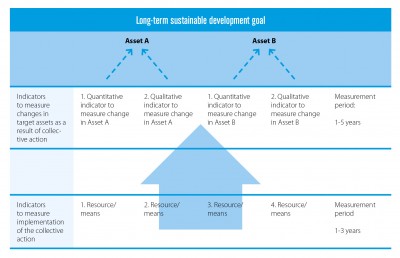The Self-Assessment Tool for Sustainable Local Development (SAT4SLD) helps local actors assess their current status and make strategic plans for a more sustainable future by simultaneously addressing governance, socio-economic, and environmental issues.
Four universal sustainable development goals provide the integrating framework for the SAT4SLD, which are:
- Fair distribution and efficient use of public and natural resources
- Equal access to quality public services
- Employment generation and equal job opportunities, and
- Honest and responsive government
These four goals can only be achieved when the local government, community, and private sector make joint efforts. For their greater willingness to work together, relations among them should be governed by the principles of long-term vision, transparent decision making, inclusion and empowerment, and incentives and regulation.
The SAT4SLD has three stages to be carried out while developing a locality’s strategic plan:
Stage 1: Situation Analysis
There are four main actors: 1) Local government, 2) Community, 3) Private Sector, and 4) Environment (actors from government, civil society, and private sector with environmental interests and knowledge), and each actor has four domains of SAT4SLD. Stage 1 maps how existing national and local strategies and plans connect to the total 16 domains.
| Local Government | Community | Private sector | Environment |
|---|---|---|---|
| Basic and social services | CSO landscape | Business landscape | Natural resource management |
| Planning, infrastructure investment and land development | Gender equality | Business support services | Disaster risk reduction and climate adaptation |
| Financial management and procurement | Social cohesion | Labour | Sustainable agriculture |
| Administrative and support services | Participation and public debate | Business integration | Sustainable energy |
Next, the task force members who represent main actors will identify main stakeholder groups and sub-groups as well as the method of data collection. Then they need to conduct meetings with the identified stakeholders for self-assessment by answering questions for its related sector. (A question list is shown in p.33 – p.35 of the guide.) To record responses to these questions, SAT4SLD uses a simple ranking of 1 to 5 about the current situation in the locality:
- Does not meet this condition
- Condition is satisfied according to plan/law but in practice cannot be satisfied because funds, capacity, and/or awareness is lacking
- Partially satisfied
- Meets this condition but improvements are still desirable
- Satisfies this condition and no additional efforts needed
Stage 2: Problem Identification
The task force first reviews the list of the most important development priorities indicated during the self-assessment process to formulate local goals and common vision. Each identified priority area in the list should be accompanied by a long-term vision statement which is a positive and future-oriented statement (5-10 years).
The SAT4SLD highlights the need for collective action among the main actor groups because complex sustainability challenges cannot be addressed by one actor alone. To identify appropriate collective actions, the task force should analyze each long-term local sustainable development goal separately by conducting SWOT analysis (a structured planning method used to evaluate the Strengths, Weaknesses, Opportunities and Threats). The SWOT analysis may reveal that separate short-term interests are needed to reach consensus and groups of activities will be recommended to support each other.
Then the next step is to form a collective action plan based on common interest and available resources.
Stage 3: Asset-Based Monitoring (ABM)
Prioritize the assets to be monitored. These assets will fall under one of seven forms of capital for sustainable local development: 1) physical capital, 2) institutional capital, 3) social capital, 4) human capital, 5) financial capital, 6) know-how, and 7) natural capital. The task force will create indicators which should be SMART (specific, measurable, attainable, relevant and time bound) for the selected assets and a baseline. Asset-based indicators need to be incorporated into the regular planning process of local government departments and other local actors to be measured periodically. Also, public commitment to targets should be broadly made by local governments, civil society, and business leaders.
